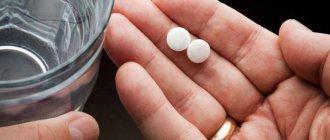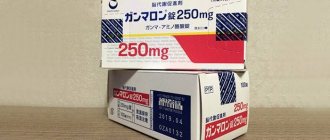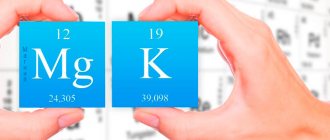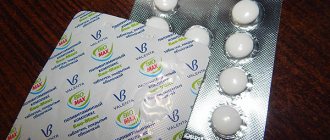Compound
- One hard gelatin capsule of Mildronate contains 250 or 500 mg of meldonium in the form of dihydrate as an active component and excipients: potato starch, colloidal silicon dioxide, calcium stearate. Gelatin and titanium dioxide are used to make the gelatin shell.
- One Mildronate tablet contains 500 mg of meldonium in the form of phosphate and auxiliary components: mannitol E421, povidone K-29/32, potato starch, silicon dioxide, microcrystalline cellulose, magnesium stearate.
- One milliliter of Mildronate injection solution contains 100 mg of meldonium and water for injection as an auxiliary component.
Composition and release form
The drug is produced by several manufacturers, and its composition depends on the form of release. It is presented on the pharmaceutical market in two forms:
- solution for injection, 1 ml contains 100 mg of meldonium dihydrate;
- capsules with a dosage of the main active ingredient of 250 or 500 mg.
The capsules contain excipients - magnesium stearate, potato starch, silicon dioxide and microcrystalline cellulose. Contents: hygroscopic white powder. In pharmacies it is sold in cardboard boxes of 30, 40, 60 pieces.
The solution is a slightly yellowish or transparent substance, containing water for injection as an excipient. Sold in 5 ml ampoules of 10 pieces, packed in cardboard boxes.
The solution for injection into a vein or muscle has the fastest absorption (immediately after administration), but it is more convenient to take capsules at home.
Release form
The drug Mildronate is produced by the manufacturer in the form:
- clear colorless solution for injection;
- hard gelatin capsules No. 1 and No. 2, filled with hygroscopic white crystalline powder. The powder contained in the capsules has a weak characteristic odor and a sweetish taste (the capsule itself has a neutral taste);
- tablets Mildronate Gx 500 mg (tablet taste slightly sour).
The solution is sold in 5 ml ampoules (500 mg/5 ml). One cardboard package contains: 2 blister packs with 5 ampoules of Mildronate in each and instructions for use of the drug.
Capsules are packaged in blisters of 10 pieces each. One cardboard box contains 4 blisters and instructions for use of the drug.
pharmachologic effect
Meldonium is a synthetic drug that has a similar effect to γ-butyrobetaine (a substance that is a precursor to hydroxytrimethylaminobutyric acid, a natural vitamin-like substance related to B vitamins).
According to Wikipedia, meldonium is characterized by its ability to improve metabolism and energy supply to cells and is used as:
- cardioprotective;
- antihypoxic;
- angioprotective;
- antianginal agent.
The mechanism of action of meldonium determines a wide range of its pharmacotherapeutic properties. Taking this drug helps improve performance, reduces the severity of manifestations of mental, intellectual and physical stress, and activates tissue and humoral immunity.
In patients suffering from heart failure , it increases the strength of contractions of the heart muscle, reduces the frequency of heart attacks ( angina ), and also increases the body's tolerance to physical activity.
In case of acute myocardial damage, the use of meldonium slows down the formation of necrotic zones, shortens the duration of the rehabilitation period, normalizes blood circulation in the area of ischemic damage and redistributes blood in favor of the ischemic area.
Under conditions of increased stress, meldonium helps restore the balance between the transport of oxygen into cells and the cells' need for it, prevents the accumulation of cellular metabolic products and toxic substances in cells, protects cells and cellular structures from damage, ensures rapid compensation by the body of its energy reserves and maintains the highest speed metabolic processes.
By toning the central nervous system, meldonium effectively eliminates disturbances in the functional state of the somatic and autonomic (autonomic) parts of the nervous system, including disorders that accompany withdrawal syndrome in patients suffering from chronic alcoholism .
In addition, the substance has a beneficial effect on the condition of dystrophically altered retinal vessels, which makes it possible to use it for the treatment of vascular and dystrophic pathologies of the fundus.
Pharmacodynamics and pharmacokinetics
The action of the active substance of the drug is aimed at inhibiting the enzymatic activity of γ-butyrobetaine hydroxylase, which is the last enzyme in the chain reaction of l-carnitine .
Meldonium helps reduce the concentration of free carnitine , prevents the transport of long-chain fatty acids across cell membranes, and prevents the accumulation in cells of activated forms of unoxidized fatty acids, which are derivatives of acylcarnitine and acyl coenzyme .
In ischemic tissues, it restores the balance between the transport of oxygen and its absorption by cells, prevents disruption of the transport of adenosine triphosphate, while simultaneously activating glycolysis, which occurs without additional oxygen consumption.
The result of a decrease in carnitine concentration is increased synthesis of the vasodilator γ-butyrobetaine.
After taking Mildronate tablets per os, the meldonium it contains is quickly absorbed in the digestive tract. The drug is characterized by a fairly high bioavailability index. The latter is approximately 78%.
The concentration of meldonium in the blood plasma reaches its maximum values an hour or two after administration. In the body, meldonium is metabolized to non-toxic products - glucose, succinate, 3-hydroxypropionic acid.
Metabolites are excreted by the kidneys. The half-life (T½), depending on the characteristics of the particular organism and the dose taken, can range from three to six hours.
The drug in injection form is characterized by 100% bioavailability. The concentration of meldonium in the blood plasma reaches its maximum values immediately after administration of the drug. The half-life (T½), depending on the characteristics of the particular organism and the dose taken, can range from three to six hours.
The result of the metabolization of meldonium is the formation of non-toxic metabolites (glucose, succinate, 3-hydroxypropionic acid), which are then excreted from the body by the kidneys.
Indications for use of Mildronate
What are Mildronate tablets for and what is the medicine for in the form of injections?
All dosage forms of the drug are intended for the treatment of adult patients.
Indications for use of Mildronate (for all dosage forms of the drug):
- IHD (in combination with other drugs and treatment methods);
- peripheral artery disease;
- reduced performance;
- encephalopathy;
- physical overload (including in sports);
- postoperative period (to speed up the recovery of the body);
- chronic heart failure
- cardialgia (pain in the left side of the chest) caused by dyshormonal myocardiopathy ;
- bronchial asthma;
- COPD;
- alcohol withdrawal (as an addition to specific therapy);
- stroke.
Additional indications for the use of drug injections:
- hemorrhage into the vitreous cavity of the eye ( hemophthalmos );
- hemorrhage in the retina of the eye;
- thrombosis and occlusion of the central retinal vein or its branches;
- retinopathy of various origins (for example, hemorrhagic or diabetic ).
Use of Mildronate in sports
Mildronate is a drug that is characterized by the ability to expand the range of tolerance to physical (both dynamic and static) stress and intellectual function not only in ischemic injuries, but also in healthy people.
The drug is very useful for athletes due to its properties to improve the nutrition of the heart muscle and other muscles of the body and reduce fatigue, while simultaneously increasing the effectiveness of sports training.
Contrary to popular belief, Mildronate is not used as a means to increase muscle mass. Its task in sports and in bodybuilding in particular is somewhat different: Mildronate for athletes is indicated as a prophylactic agent that prevents fatigue (including the heart muscle) and overtraining.
In addition, by promoting faster removal of breakdown products from cells and accelerating the restoration of cellular energy resources, Mildronate improves metabolism at the cellular level and accelerates muscle recovery in athletes after physical activity. Moreover, the latter applies to both strength loads and physical loads on the speed and/or endurance of the body.
There is an opinion that the use of Mildronate in sports can provoke fatty liver hepatosis . However, it is unfounded.
Mildronate prevents fatty acids from penetrating into the cells and thus prevents the accumulation of fats in the liver. In addition, by burning predominantly sugar, the body spends a larger amount of raw materials, which are fats, for each molecule of adenosine triphosphate produced ( that is, for energy production).
Meldonium was not classified as a doping drug until January 1, 2021, which made it possible to use it absolutely legally in all sports.
However, after the introduction of a ban on the use of the drug by the World Anti-Doping Agency (WADA) at the beginning of 2021, a number of athletes, mainly from Russia and the former CIS countries, were caught using this drug. Mildronate also became the subject of a huge scandal when Maria Sharapova admitted using this doping on March 7, 2021.
Indications for use
Meldonium is prescribed as an additional therapy for serious diagnoses and certain conditions:
- cardiac ischemia;
- myocardial dysfunction;
- disruption of blood supply to the brain as a result of a stroke;
- rehabilitation period after surgical interventions;
- heavy physical activity;
- low performance, weakness and chronic fatigue;
- withdrawal syndrome in chronic alcoholism;
- dishormonal cardiomyopathy.
The drug is administered by injection through the skin of the lower eyelid for hemorrhages, circulatory disorders or thrombosis of the veins in the retina, pathologies of the fundus vessels, as well as for diabetic or hypertensive retinopathy.
Side effects
Side effects caused by taking Mildronate occur quite often. Typically they are expressed as:
- allergic reactions (redness, skin rashes, itching and swelling);
- dyspeptic symptoms, manifested by belching, attacks of nausea, vomiting, heartburn, a feeling of fullness in the stomach even after a small portion of food;
- tachycardia;
- increased arousal;
- decrease in blood pressure.
Contraindications and side effects
The drug is contraindicated in:
- individual intolerance;
- hypersensitivity to components;
- increased intracranial pressure due to impaired venous outflow or brain tumors.
Negative effects are rare and may include:
- tachycardia;
- increased nervous excitability;
- allergic reactions – itching, urticaria;
- digestive disorders;
- changes in blood pressure downwards or upwards.
With the correct dosage, side effects usually do not occur; if they appear, it is recommended to discontinue the drug.
Instructions for use of Mildronate
You can often come across questions “.. can Mildronate be administered intramuscularly?” or “.. is it possible to inject the drug intramuscularly?”
The instructions for medical use indicate that the drug in injection form is intended for intravenous administration, and capsules and tablets are intended for oral administration (per os).
Dosage forms for oral administration should be taken whole, without chewing, crushing or pouring out the contents of the capsules.
Mildronate for intravenous administration is produced in finished form. Mildronate should be administered intravenously separately from other drugs; dilution with an aqueous solution of sodium chloride is not required (however, in some cases it is allowed).
When injected into a muscle, the injection solution has an irritating effect and can provoke local pain and local allergic reactions. For this reason, the drug Mildronate is usually injected into a vein.
Mildronate injections: instructions for use, why they are prescribed and how to dose the injection solution
Indications for the use of Mildronate injections: unstable (progressive) angina pectoris , myocardial infarction , vascular pathologies of the fundus and cerebral circulatory disorders.
For patients with coronary syndrome, the drug is administered into a vein as a bolus at a dose of 500-1000 mg once a day. After this, therapy is continued by taking tablets or capsules.
For patients with vascular pathologies of the fundus of the eye, the medicine is administered retrobulbarly (behind the eyeball) or subconjunctivally (under the outer shell of the eyeball) 0.5 ml for 10 days.
For patients with cerebral circulatory disorders in the acute stage, the solution is administered into a vein once a day at a dose of 500 mg. The duration of the therapeutic course is 10 days. Further treatment is carried out using oral dosage forms.
Patients with chronic cerebral circulatory disorders are advised to administer Mildronate intramuscularly one to three times a day at a dose of 500 mg (optimally before lunch). The duration of the therapeutic course is from 2 to 3 weeks.
Mildronate tablets: instructions for use
For patients with diseases of the cardiovascular system, Mildronate tablets and capsules are indicated in combination with specific therapy. The drug is taken at 500-1000 mg per day. The entire dose can be taken either at once or divided into two doses.
As a rule, the course of treatment lasts from 4 to 6 weeks.
For cardialgia caused by dishormonal myocardiopathy , Mildronate is taken once a day, one 500 mg tablet or 2 250 mg tablets.
For patients with cerebral circulatory disorders, after eliminating acute disorders, the drug is recommended to be used at a dose of 500-1000 mg per day. Take it in one dose or divided into two doses.
Patients with chronic cerebral circulatory disorders are recommended to take 500 mg of Mildronate per day.
The duration of treatment varies from 4 to 6 weeks. At the discretion of the attending physician, the patient may be prescribed repeated courses of treatment (usually two or three times a year).
Patients with pathologies of peripheral arteries are prescribed to take the drug twice a day, 500 mg. The recommended dose for increased intellectual and physical stress on the body (including athletes) is 1000 mg, which should be divided into two doses.
The duration of treatment is from 10 to 14 days. If necessary, the course is repeated after a two- or three-week interval.
In the period before training, athletes are recommended to take Mildronate twice a day at a dose of 500-1000 mg. The duration of treatment in the preparatory period is usually from two to three weeks; during the competition period its duration varies from 10 to 14 days.
For alcohol withdrawal , patients suffering from chronic alcoholism should take Mildronate 500 mg four times a day. The duration of the course is from 7 to 10 days.
The maximum permissible daily dose is considered to be 2000 mg.
Meldonium: methods of application and doses
Depending on the dosage form used, the drug is prescribed orally, intravenously, intramuscularly or by eye injection.
The method, duration of therapy and dose are determined based on the indications and severity of the condition individually.
Instructions for use of Meldonium provide for several capsule administration regimens:
- for heart disease - 500-1000 mg per day, once or in two doses, with a course of treatment of 1-1.5 months;
- in case of impaired cerebral circulation - 500-1000 mg per day for 1-1.5 months;
- for chronic alcohol intoxication, the dose reaches 500 mg in 4 doses per day, the course is up to 10 days;
- with systematic heavy physical activity, during the rehabilitation period after surgery - 250 mg 4 times a day for two weeks.
Athletes are prescribed capsules of 500-1000 mg twice a day before training and during competitions for 2-3 weeks.
When prescribing injections, the dose is 500-1000 mg per day.
For unstable angina, a condition after myocardial infarction, the solution is administered intravenously, 1-2 ampoules once a day for 4 days.
0.5 ml of the drug with a concentration of meldonium of 500 mg per 5 ml is injected into the retina of the eye, the course of treatment is 10 days.
Interaction
Combination of Mildronate with antianginal, antiarrhythmic, anticoagulant, antiplatelet and diuretic drugs, cardiac glycosides, bronchodilators and other drugs is allowed.
Mildronate has the ability to potentiate the effect of Nitroglycerin and β-adrenergic blockers, Nifedipine and other drugs with coronary action, antihypertensive drugs, as well as drugs whose action is aimed at dilating peripheral blood vessels.
Due to the possible development of moderate tachycardia and a decrease in blood pressure, the above drugs should be used in combination with Mildronate with caution.
Overdose
Subject to the conditions of use, Mildronate does not exhibit toxic properties to specific organs and systems. There have been no documented cases of meldonium overdose resulting in severe consequences.
If the therapeutic dosage is exceeded for hypotension, the following symptoms can be expected: headache, dizziness, general malaise, severe tachycardia, instability of blood pressure.
There is no specific antidote; in case of overdose, symptomatic treatment is carried out aimed at relieving pathological manifestations. In case of severe overdose, strict control of the function of the kidneys and liver is necessary as the organs that interact with the drug the most.
Hemodialysis is not effective in case of an overdose of Mildronate due to the high binding coefficient to blood proteins.
special instructions
Due to the fact that the drug can provoke a stimulating effect, it is recommended to use it in the first half of the day.
There are no data regarding the ability of Mildronate to change the reaction rate and influence transport control.
The drug is prescribed with caution to people with liver and/or kidney pathologies.
Experience in treating patients with myocardial infarction and unstable angina shows that the active substance Mildronate is not a first-line drug for ACS.
Analogues of Mildronate
Level 4 ATX code matches:
Vazonat
Phosphaden
Hawthorn fruit
Preductal
Meldonium
Angiosil Retard
Ranexa
Lily of the valley tincture
Neocardil
Rimecore
Triductane
ATF-Long
Hawthorn tincture
Triductan MV
Trimectal MV
Trimectal
Neoton
Predisin
Trimetazidine
Tivortin Aspartate
Analogues of Mildronate:
- Vasopro
- Vazonat
- Metamax
- Methonate
- Trizipin
- Mildracore
- Mildrocard
- Cardionate
- Melfort
- Idrinol
- Riboxil
- Meldonium
The price of drug analogues starts from 170 rubles.
Riboxin or Mildronate - which is better?
Riboxin is a natural compound found also in the human body.
Being a precursor of adenosine triphosphate , it helps to increase the energy balance of the heart muscle, improve coronary circulation, reduce the severity of the consequences of intraoperative ischemic kidney damage, stimulate the production of nucleotides and the activity of individual enzymes of the citrate cycle.
The drug has a positive effect on metabolic processes in the heart muscle, increases the force of its contractions and stimulates its more complete relaxation in diastole, which in turn leads to an increase in stroke volume (stroke volume of blood).
Mildronate has a similar effect, but is not itself involved in the synthesis of other substances. At the same time, the drug regulates the activity and biosynthesis of enzymes involved in energy production, and thus normalizes metabolism.
The conclusion is this: Mildronate is a drug whose action is aimed at correcting metabolic processes, while Riboxin takes part in biochemical reactions and is a means of metabolic action.
To obtain the expected effect from the use of Riboxin, it should be administered in quantities that are comparable to its consumption in the body. And since Riboxin is used by the body in various reactions, it is required in very large quantities.
Mildronate, on the contrary, is not consumed in metabolic reactions, its effect lasts for a longer period of time, and its body requires much less than Riboxin.
Therefore, the use of Mildronate also improves the body’s use of Riboxin. Thus, the combined use of these drugs will potentiate each other's effects.
Cardionate or Mildronate - which is better?
Cardionate and Mildronate are synonymous drugs. They are based on the same active ingredient, so both products have a similar mechanism of action.
The only difference is that, unlike Mildronate, Cardionate is available only in the form of 250 mg capsules and 500 mg/5 ml injection solution.
Instructions for use of the drug
The use of Mildronate for the accelerated recovery of patients after injuries, major operations and cardiovascular accidents is due to the effect of the drug on metabolic processes in the body's cells. Safety, convenient use and effectiveness after short courses are the main reasons for prescribing the product.
Uncontrolled use by patients (usually athletes) often leads to side effects, so Mildronate is sold in pharmacies only with a doctor’s prescription.
Indications: what is it prescribed for and for what purpose?
The instructions for use of Mildronate highlight a list of pathologies for which the effectiveness of the drug has been proven in clinical studies and approved by recommendations.
Conditions for which the use of the medication is recommended are presented in the table.
| Affected organ | Indications for the use of Mildronate |
| Heart |
|
| Brain |
|
| Respiratory system |
|
| Eyes |
|
General indications include:
- withdrawal syndrome (“withdrawal”) and hangover in patients with alcoholism;
- decreased exercise tolerance, chronic fatigue and drowsiness;
- decreased memory and performance, which are accompanied by headaches and tinnitus;
- in children – cardialgic variant of vegetative-vascular dystonia.
In addition, Mildronate is often used among athletes (boxing, powerlifting and others) to achieve high results in competitions, improve endurance and strength.
Composition of the drug and mechanism of action
"Mildronate" (international nonproprietary name - Meldonium) belongs to a group of metabolic agents that affect metabolic processes and are widely used in cardiology and neurology.
Mechanisms for realizing the effects of the drug:
- Inhibition of the oxidation of fatty acids (FA) in cells and their transport through membranes. Excess FA contributes to the development of “oxygen starvation” due to increased gas consumption for the utilization of metabolic products.
- Stimulation of the synthesis of nitric oxide by the endothelium of the vascular wall, which causes expansion of the lumen and reduces signs of cardiac ischemia (clinically manifested by the elimination of chest pain).
- Reducing the overall resistance of peripheral vessels, reducing blood pressure (relevant for hypertension).
- Reducing oxygen consumption by switching to more economical metabolic pathways (aerobic glycolysis).
- Prevention of the development of sclerosis after acute ischemia of the myocardium or brain tissue.
- Slowing down the process of platelet aggregation (formation of blood clots).
The drug is available in different forms for ease of use at the outpatient and hospital stages of treatment:
- capsules (250; 500 mg);
- syrup for oral use;
- 10% solution in ampoules for intravenous, intramuscular and parabulbar injections.
Directions for use and doses
The choice of dosage regimen, optimal dosage and duration of Mildronate therapy depends on:
- underlying disease (duration, severity);
- concomitant pathologies;
- age, gender, weight of the patient.
In clinical practice, doctors often use step therapy for acute conditions: transferring patients from enteral use (injection) to oral administration while maintaining the effective dose.
Oral administration
Meldonium capsules and syrup are intended for internal use. Basic recommendations:
- in the first half of the day (taking in the afternoon is accompanied by a risk of insomnia);
- Do not chew the capsules;
- drink enough water;
- regardless of food intake.
Doses of the drug for various indications for the use of Mildronate are presented in the table.
| Disease | Application diagram |
| IHD, CHF | 1 capsule (500 mg) 2 times a day for 2 weeks |
| ONMK | 500 mg 2 times a day for 1-1.5 months |
| Dysmetabolic cardiomyopathy | 1 capsule (500 mg) 1 time per day – 10-12 days |
| Bronchial asthma | 250 mg 1 time per day – 1 month |
| Encephalopathy | 500 mg/day for 1-1.5 months |
| Chronic alcoholism | 500 mg 4 times a day for 1-2 weeks |
| Decreased exercise tolerance | 1 capsule (250 mg) 2-3 times a day for 2 weeks |
Dose adjustment is carried out depending on the patient's sensitivity to the drug. Oral use is most often prescribed to non-severe patients for outpatient treatment.
Intramuscular and intravenous administration options
"Mildronate" for parenteral use is available in the form of an injection solution (or droppers), which is prescribed to patients at the stage of inpatient treatment in the complex therapy of various diseases. The method of administration and duration of the course are selected by specialists depending on the course of the pathology.
The Mildronate treatment regimen for parenteral use is presented in the table.
| Diseases | Dosage regimen |
| Acute conditions: myocardial infarction (MI), stroke | 500-1000 mg/day for 10-14 days, followed by switching to the oral form |
| Cerebrovascular insufficiency | 500 mg/day – 14 days |
| CHF | 500-1000 mg/day – 1-1.5 months |
| Alcoholism and other forms of addiction | 500-1000 mg/female – 7-10 days |
| Asthenovegetative syndrome after injuries, major operations | 500 mg/day – 2 weeks |
| Post-traumatic or dysmetabolic retinopathy | 50 mg/day for 10 days parabulbarly (in the area of the lower eyelid) or subconctivally. |
The prophylactic dose is prescribed to patients with a high risk of developing a recurrent stroke or heart attack (assessed on special scales) and is half the therapeutic dose.
Contraindications for use
The instructions for use of Mildronate define a number of conditions in which the use of the product is prohibited or limited.
Contraindications to the use of the medication:
- a history of allergic reactions to the use of Meldonium or other components of the drug;
- pregnancy period (active metabolites of the drug penetrate the hematoplacental barrier into the child’s body);
- women during breastfeeding: clinical studies have not confirmed the penetration of the drug into milk, but it is not recommended for use during lactation;
- oncological pathologies;
- children's age (for capsules and oral administration - 18 years, for syrup - 12 years);
- intracranial hypertension of various etiologies (malignant neoplasms, trauma, congenital cysts and CSF defects).
- renal or liver failure: impaired metabolism and excretion of the drug contributes to the development of overdose and toxic effects.
Cautious use is recommended in patients with epilepsy due to the pronounced stimulating effect of the drug. If there are contraindications to Mildronate, it is necessary to use products with similar properties.
Side effects
Metabolic drugs, to which Mildronate belongs, are safe and have a small number of undesirable consequences after administration.
Side effects from use:
- allergic reactions (itching rash, dermatitis, swelling and redness of tissue in the injection area);
- headaches, dizziness (more often in hypertensive patients due to increased intracranial pressure);
- increased excitability, irritability, sleep disorders (usually insomnia);
- rhythm disturbances: atrial fibrillation, sinus tachycardia with a feeling of interruptions in the work of the heart;
- lability of blood pressure (“jumps” of high and low values);
- dyspeptic disorders: abdominal discomfort, nausea, metallic taste in the mouth, diarrhea;
- muscle weakness, back pain;
- with parenteral administration: sensation of heat or cold, tissue swelling, pain at the injection site.
Laboratory tests determine changes in lipid ratios, increased levels of C-reactive protein (a marker of inflammation) and eosinophils.
Mildronate is one of the few drugs that are used in sports without affecting potency in men, unlike hormonal anabolics.
Symptoms of overdose and methods of dealing with them
Exceeding the dose of the drug, impaired excretion (due to liver or kidney pathology) contribute to the accumulation of active metabolites of Mildronate and the development of intoxication.
Signs of drug overdose:
- headache;
- general weakness;
- vertigo (dizziness);
- noise in ears;
- loss of consciousness (rare);
- sudden hypotension (drop in blood pressure);
- tachycardia (rapid heartbeat).
There is no specific antidote; detoxification (infusion) therapy with monitoring of the functional state of the excretory system is recommended. The effectiveness of extracorporeal methods (eg, hemodialysis) has not been confirmed.
Alcohol compatibility
The active substance of Mildronate is excreted from the body within 12 hours, therefore, after this time, the risk of interaction of the drug with another active substance is extremely low or completely absent.
In general, drinking alcohol during treatment with Mildronate is not prohibited; however, if this drug is used to treat a cardiovascular disease or a cerebral circulatory disorder, the patient is still advised to stop drinking alcohol.
This is due to the fact that taking the drug in combination with alcohol can negate all the positive results that have been achieved in treating the disease.
Taking Mildronate with alcohol can provoke:
- tachycardia;
- pronounced allergic reactions ;
- sharp fluctuations in blood pressure;
- dyspeptic symptoms.
The poor compatibility of Mildronate with alcohol is due to an increased risk of various types of complications and the likelihood of a relapse of the disease. For this reason, alcohol should be excluded for the entire period of treatment with the drug.
Contraindications for use
- age under 18 years (based on the lack of data from isolated clinical studies on the tolerability of Mildronate in patients under the age of 18);
- hypersensitivity to meldonium or other components that are part of the drug, episodes of anaphylactic reactions or other allergic reactions (itching, swelling, hyperthermia) in the anamnesis;
- increased intracranial pressure caused by impaired outflow of cerebrospinal fluid, impaired venous outflow (in the presence of an obstructed vessel or intracranial tumor);
- end-stage liver and kidney failure: the drug will not be able to undergo transformation in these organs, so conversion and elimination will be impaired and toxicity will increase;
- pregnancy;
- period of lactation and breastfeeding.
Use of Mildronate during pregnancy and lactation
The safety of Mildronate for the treatment of pregnant women has not been proven. To exclude the possibility of its adverse effects on fetal development, the drug is not prescribed during pregnancy .
It has not been established whether meldonium can be excreted in the milk of a nursing woman. Therefore, if treatment with Mildronate is indicated for the mother, she must stop breastfeeding .
Contraindications and side effects
It is prohibited to use Mildronate for:
- Individual intolerance to meldonium or any of the auxiliary components.
- Increased intracranial pressure, caused, among other things, by a tumor and impaired venous outflow.
Undesirable effects from taking the drug may appear in the form of:
- Allergic manifestations - itching, rashes, redness or swelling.
- Rapid heartbeat.
- Reactions from the digestive system - nausea, vomiting, heartburn, belching.
- Excessive stimulation of the nervous system.
In general, Mildronate is a low-toxic drug that does not cause life-threatening conditions. However, Mildronate is not used in pediatrics. Also, the drug is not prescribed during pregnancy and breastfeeding.
Reviews of Mildronate
Reviews about Mildronate on forums are mostly positive . The unique mechanism of action of this drug allows it to be widely used to eliminate problems with the cardiovascular system, as well as as a means of increasing performance in healthy people who are subject to frequent physical and intellectual overload.
Both patients in cardiology departments, doctors, and athletes note the fact that Mildronate provokes a tonic effect. Its use significantly improves memory function, accelerates thought processes, increases dexterity, endurance and the degree of body resistance to adverse factors.
Reviews from cardiologists confirm the data of numerous studies that have shown that the use of Mildronate in capsules and in the form of a solution for injections can reduce the incidence of repeated myocardial infarction .
Reviews from patients about Mildronate allow us to conclude that the drug is simply necessary for people whose activities are associated with increased stress on the body, as well as during the recovery period after prolonged alcohol abuse, with pain and burning in the heart, VSD and other pathologies of the cardiovascular system .
The average rating for this product is quite high. However, sometimes you come across negative reviews about Mildronate. It is important to remember that, like any other drug, Mildronate gives a good result only if its dose and concomitant treatment (if necessary) are selected correctly.
Mildronate price
Price of the drug in Russia
You can buy 250 mg capsules in Russian pharmacies for an average of 300 rubles, 500 mg capsules for 650 rubles. The price of Mildronate for intravenous administration is 350 rubles. Price Mildronate Gx 500 mg - about 800 rubles.
Price of the drug on the Ukrainian market
The average price of Mildronate 250 mg tablets is 250 UAH. The price of Mildronate ampoules of 5 ml is 450 UAH. 500 mg capsules cost about 400 UAH per package. Mildronate GX is sold for an average of 450 UAH.
Moreover, Mildronate injections, tablets and capsules in pharmacies in Kharkov or Odessa are somewhat cheaper than in most pharmacies in the capital.
- Online pharmacies in RussiaRussia
- Online pharmacies in UkraineUkraine
- Online pharmacies in KazakhstanKazakhstan
ZdravCity
- Mildronate caps.
250 mg 40 pcs. JSC Grindeks 276 rub. order - Mildronate caps. 500 mg 60 pcs. JSC Grindeks
560 rub. order
- Mildronate solution IV, IM and parabulb. input 100 mg/ml amp. 5ml No. 10HB Pharma s.r.o.
RUB 359 order
- Mildronate solution for IM, IV and parabulb. input 0.1g/ml 5ml 20pcsHB Em Pharma s.r.o.
675 rub. order
Pharmacy Dialogue
- Mildronate 10% ampoules 5ml No. 10Grindex/HM Pharma
RUB 316 order
- Mildronate (amp. 10% 5ml No. 10) Sanitas
RUB 335 order
- Mildronate (amp. 10% 5ml No. 10)Grindex
RUR 347 order
- Mildronate (amp. 10% 5ml No. 10) Sotex
330 rub. order
- Mildronate capsules 250 mg No. 40Grindex
RUB 222 order
show more
Pharmacy24
- Mildronate 0.5 g/5 ml 5 ml No. 10 solution AT "Grindeks", Latvia
830 UAH. order - Mildronate 500 mg N60 capsules AT "Grindeks", Latvia
409 UAH order
- Mildronate GX 500 mg N60 tablets AT Grindeks, Latvia
442 UAH order
- Mildronate 5 ml N10 solution AT "Grindeks", Latvia/HBM Pharma s.r.o., Slovakina
461 UAH order
PaniPharmacy
- Mildronate capsule Mildronate caps. 0.25g No. 40 Latvia, Grindeks
251 UAH order
- Mildronate GX tablets Mildronate GX tablets 0.5g No. 60 Latvia, Grindeks
487 UAH. order
- Mildronate ampoule Mildronate solution d/in. 10% amp. 5ml No. 10 Lithuania, Sanitas
450 UAH. order
- Mildronate solution d/in.amp.0.5g/5ml 5ml N20
901 UAH. order
- Mildronate capsule Mildronate caps. 0.5g No. 60 Latvia, Grindeks
412 UAH. order
show more









